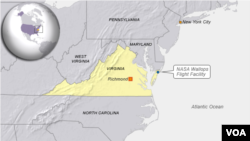An unmanned commercial rocket that was supposed to send a cargo ship to the International Space Station exploded Tuesday, six seconds after liftoff from a NASA launch pad in Virginia.
The privately owned rocket barely got off the ground before it blew up just after sunset on Wallops Island, off the Atlantic coast.
There was no one on board and no one on the ground was hurt. All the damage was limited to the so-called hazard area. Officials say the investigation has already begun.
A number of still photographs taken on October 23, in the lead up to the Antares rocket launch, show a number of final checks being undertaken on the Cygnus spacecraft.
The pictures, supplied by NASA, show Orbital Sciences Corp. completing the final cargo load ahead of Tuesday's launch and the Orb-3 Mission's payload fairing, or casing, around the Cygnus spacecraft, being installed.
The accident is the first since NASA turned to private operators to deliver cargo to the International Space Station.
The six crew members in orbit aboard the space station - two NASA astronauts, one from the European Space Agency and three Russian cosmonauts - watched the launch via a NASA TV feed, said Mike Suffredini, the space station program manager.
With a Russian cargo ship due to reach the space station on Wednesday, just 14 hours after the explosion in Virginia, the loss of the Cygnus vessel posed no immediate problem for the orbiting team.
Orbital Sciences stock fell 15.5 percent to a two-month low of $25.65 in after-hours trading.
The cause of the mishap was under investigation, said Frank Culbertson, Orbital Sciences executive vice president.
NASA official William Gerstenmaier says launching rockets is a really tough and demanding business, but that NASA has confidence in the company.
Orbital Sciences is one of two private companies NASA hired to fly cargo ships into orbit after the space shuttle fleet was retired in 2011.
Some information for this report comes from AP and Reuters.







